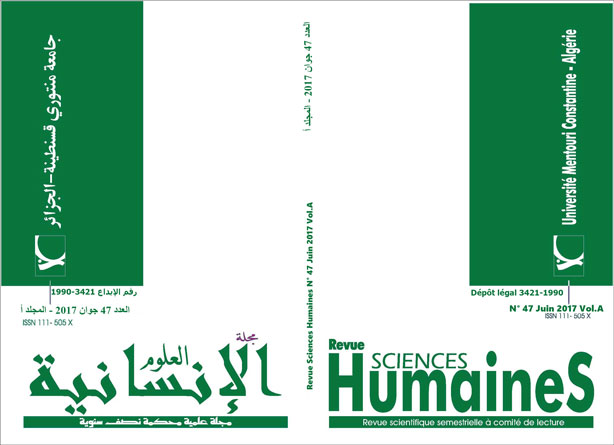An Integrated Reading/Writing Instruction for Better EFL Trainees at the Teachers Training School of Constantine (ENSC)
Keywords:
Integrated, Reading, Writing Instruction, EFL Trainees, Teachers Training School, Constantine, ENSCAbstract
Several studies acknowledge the importance of integrating reading and writing in one subject but few EFL contexts seem to consider this claim. Teachers Training School of Constantine (ENSC), Algeria, is a standing case where these two language skills are till nowadays taught as discrete subjects neglecting new ways of a more meaningful learning. This paper reports the findings of an empirical study which investigates the impact of the implementation of an integrated reading/writing instruction through the use of reading response journals (RRJs) on trainees' achievements in these two skills. An experimental design is used where a treatment intervention is applied preceded by a pretest and followed by a posttest. A quantitative analysis is conducted confirming that teaching EFL reading and writing in an integrated way through RRJs helped enhance trainees' level in both skills.
Downloads
References
Almansour, N. & Alshorman, R. (2014). The effect of an extensive program on the writing performance of Saudi EFL university students. International Journal of Linguistics, 6: 247-264
Alqadi, K. & Alqadi, H. (2013). The effect of extensive reading on developing the grammatical accuracy of the EFL freshmen at Al-Bayt University. Journal of Education and Practice, 6: 106-113
Arciuli, J. ( 2009). Introduction to the special issues of reading and writing: “Lexical representations in reading and writing”. Reading and Writing. 22( 6): 633-635
Blachowicz, C., & Ogle, D. (2008). Reading Comprehension: Strategies for Independent Learners. New York: Guildford Press
Carlisle, A. (2000). Reading logs: An application of reader response theory in ELT. ELT Journal, 54 (1): 12-19
Dowrick, S. (2009). Creative Journal Writing: The Art and Heart of Reflection. New York: Penguin Group Inc.
Eisterhold, J. (1990). Reading/writing connections: Toward a description for second language learners. In B. Kroll (Ed.). Second Language Writing: Research Insights for the Classroom ( 88-101).Cambridge: Cambridge University Press
Evans, S. (2007). Reading reaction journals in EAP courses. ELT Journal, 62 (3): 240-247. Oxford University Press
Grabe, W. (1991). Current developments in second language reading research. TESOL Quarterly, 25 (3): 375-406
Graham, S., & Hebert, M. A. (2010). Writing to read: evidence for how writing can improve reading. A Carnegie Corporation Time to Act Report. Washington, DC: Alliance for Excellent Education
Grambrell, L. B, Malloy, J.A, & Mazzoni, S.A. (2007). Evidence-based best practices for comprehensive literacy instruction. In L.B, Grambrell, L. M. Morrow & M. Pressley (Eds). Best Practices in Literacy Instruction (11-29). New York: Guilford Press
Krashen, S. (1985). Writing: Research, Theory, and Applications. New York: Pergamon Press
Kucer, B. S. (2009). Dimensions of Literacy: A Conceptual Base for Teaching Reading and Writing in School Settings. New York & London: Routledge
Kurland, E. & Rohr, R. (2009, May). (Truly) Integrating reading and writing in the post-secondary ESL classroom. Paper presented at M.A. TESOL conference on Cultivating Learners, Harvesting Success, San Francisco State University
Lems, K. , Miller D. L. & Soro M.T. ( 2010). Teaching Reading to English Language Learner: Insights from Linguistics. New York: Guilford Press
Ming-Yue, S. (2009). Reading-Writing connection for EFL college learners’ literacy development. The Asian EFL Journal Quarterly. 11(1): 87-106
Rosenblatt, L. M. (2004). The transactional theory of reading and writing. In R.B, Ruddell & N. J, Unrau (Eds). Theoretical Models and Processes of Reading, 48, 1363–1398: International Reading Association
Silberstein, S. (1994). Techniques and Recourses in Teaching Reading. London: Oxford University Press
Stotsky, S. (1983). Research on reading/writing relationships: A synthesis and suggested directions. Language Arts, 60 (5): 627-642
Yoshimura, F. (2009). Effects of connecting reading and writing and a checklist to guide the reading process on EFL learners’ learning about English writing. Procedia Social and Behavioral Sciences, 1: 1871-1883
Zhou, L. & Siriyothin, P. (2009). An investigation of university EFL students' attitudes towards writing-to-read tasks. Suranaree J. Sci. Technol, 16(4): 297-309
















